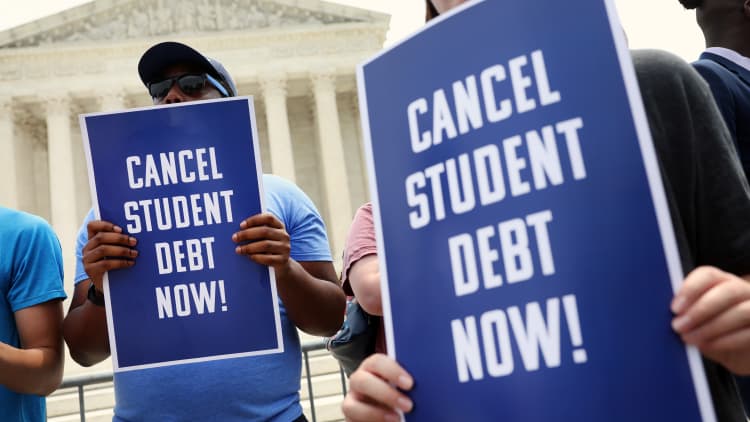Republican presidential nominee and former U.S. President Donald Trump and Republican vice presidential nominee J.D. Vance applaud during Day 1 of the Republican National Convention (RNC), at the Fiserv Forum in Milwaukee, Wisconsin, U.S., July 15, 2024.
Brian Snyder | Reuters
Among the policy issues that Donald Trump and his newly chosen running mate Sen. JD Vance of Ohio agree on: Student loan borrowers should not get their debt canceled.
“Forgiving student debt is a massive windfall to the rich, to the college educated, and most of all to the corrupt university administrators of America,” Vance, a Yale Law School graduate and the author of “Hillbilly Elegy,” wrote on X in April 2022. “Republicans must fight this with every ounce of our energy and power.”
Outstanding education debt in the U.S. stands at around $1.6 trillion. Nearly 43 million people — or 1 in 6 adult Americans — carry student loans. Women and people of color are most burdened by the debt, research shows.
Vance seems to approve of loan forgiveness in extreme cases. In May, he helped introduce legislation that would excuse parents from student loans they took on for a child who became permanently disabled.
Vance’s office did not respond to requests for comment.
GOP efforts to eliminate student loan forgiveness
Vance’s readiness to fight student loan forgiveness policies could pose a threat to the Biden administration’s recent efforts to reduce or eliminate people’s debts, experts say. Those relief measures are already under attack by Republicans.
In response to lawsuits brought by several red states, including Arkansas, Florida and Missouri, two federal judges in Kansas and Missouri temporarily halted major provisions of the U.S. Department of Education’s new affordable repayment plan for borrowers in late June.
More from Personal Finance:
Why job skills could make or break your next interview
Why a five-day return to office is unlikely
Job market is still strong but has ‘gotten competitive’
A legal challenge from six GOP-led states — Nebraska, Missouri, Arkansas, Iowa, Kansas and South Carolina — also led to the downfall of President Joe Biden’s sweeping loan forgiveness plan. The majority-conservative Supreme Court ultimately struck down Biden’s plan to cancel up to $20,000 in student debt for millions of Americans.
As president, Trump called for the elimination of the popular Public Service Loan Forgiveness initiative, and his administration halted a regulation aimed at providing loan forgiveness to those defrauded by their schools.
Meanwhile, Project 2025, a collection of policy plans developed by conservative think tank The Heritage Foundation, calls for further cuts to student loan forgiveness programs, including the elimination of several affordable repayment plans for borrowers. Several people who formerly worked for Trump were involved in creating the playbook, and a recently resurfaced video from April 2022 shows Trump speaking at a Heritage Foundation gala about the group’s plans.
“If Donald Trump is given the chance to implement this right-wing manifesto it will wreak havoc on the economic stability of millions of student loan borrowers and their families and make the student debt crisis worse,” said Aissa Canchola Bañez, the political director for Protect Borrowers Action.

‘Student debt forgiveness is a working-class issue’
Vance reiterated his view that student loan forgiveness is unfair in an interview on Fox News in August 2022.
“If you want to give student debt relief, you should penalize the people who have benefited from this very corrupt system, not ask plumbers in Ohio to subsidize the life decisions of college-educated young people, primarily young people who are going to make a lot of money over the course of their lifetime,” Vance said on “Tucker Carlson Tonight.”
That’s not an unusual stance from the right.
Conservatives typically question the fairness of forgiving the debt of those who’ve benefited from higher education, and saddling taxpayers with the costs of doing so. Just over a third of Americans aged 25 and older have a bachelor’s degree, according to an estimate by higher education expert Mark Kantrowitz.
Consumer advocates say rising costs force many families to borrow to send their children off to college, an increasingly necessary step to land in the middle class. They also point to failures in the loan system for worsening the crisis and making it harder for borrowers to pay down their debt.
Jane Fox, chapter chair of the Legal Aid Society Attorney’s union, UAW local 2325, said it was hypocritical and incorrect of Vance to frame debt relief as a benefit to those who are well off.
“Student debt forgiveness is a working-class issue,” said Fox. “Those in the 1% who went to elite institutions and then worked in private equity as Senator Vance did rarely need debt relief.”
In Ohio, where Vance is senator, student loan borrowers owe $62 billion, and carry an average balance of roughly $35,000, Kantrowitz found.







